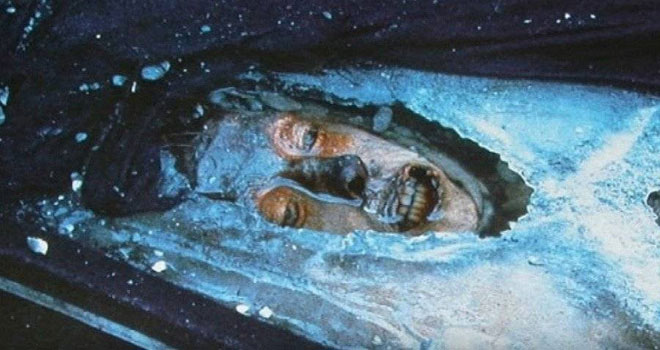The mysterious 19th-century shipwreck: What terrible thing happened to the members on board?
The cause of death for 128 members of the Franklin expedition has been puzzling for archaeologists for a long time, but a new study has taken them one step closer to the truth.
A new study published recently in the journal PLOS One rejected the previous hypothesis about the cause of the crew's death that has been so long believed.
Researchers began to investigate the real cause of sailors' deaths on the fateful train.

The body of John Torrington - member of the expedition preserved intact in the ice was discovered in 1984.
Franklin expedition
In the summer of 1845, two British ships, HMS Erebus and HMS Terror , left Greenhithe (England) to begin their journey to North America in the hope of finding the legendary Northwest Passage between the Atlantic. and the Pacific Ocean.

John Franklin.
Two ships with 134 members led by the seasoned explorer Sir John Franklin, known as the Franklin Expedition .
Although the explorers had thoroughly prepared the necessary equipment in the next 3 years, everyone understood that every expedition was never a walk.
Clues after shipwreck
The expedition lasted several months when some crew members became ill, they left the team and were taken back home.
But the fate of sailors staying on the ship and continuing the journey that year, exactly what happened to them, this became a mystery nearly 175 years later.

Arctic explorer John Franklin and members of the delegation around 1845.
The last ship was never able to dock because it was found in the ice in Victoria Sound, located between the Arctic Islands, Canada.
All members of the crew are also dead.
After the shipwreck disaster some clues gradually appeared. In 1850, three graves of Franklin Expedition sailors were found. In 1854 Scottish explorer John Rae met Inuit residents who owned some of the belongings of the expedition crew.
They also showed Rae the human bones found in the area, which sparked rumors that the last person on Franklin's expedition might have become a man-eater in the last great days. hope.
John Torrington is one of the crew. In 1984, the mummy of John Torrington was found in unbelievably perfect condition. Researchers rely on this mummy to trace the clue.
After analyzing bone and tissue samples, they found that in Torrington's body there were lethal lead levels, which could come from sailors' poor quality canned food.
According to Gizmodo, previous research on bone, hair and tissue samples from preserved corpses revealed many reasons for the deaths of sailors. But poisoning is still a leading possibility, some say sailors are poisoned. The following case also gradually sinks into oblivion.
Actually, sailors are poisoned
A recently published study rejected most of the above hypotheses. The group of researchers has proposed three other hypotheses to test the theory of lead poisoning.

The group of researchers has proposed three other hypotheses to test the theory of lead poisoning.
If true lead poisoning is the main cause of death, sailors who live longer will have lead residues in their bodies, bones, tissues . higher than other sailors during that time and also lost.
To test this, researchers used high-tech X-ray image scanning technology. The results show that the level of lead in the body does not have a big difference. Therefore, lead poisoning is now unlikely to cause death for Franklin Expedition expedition.
The cause of poisoning has been ruled out, but researchers still do not know exactly what killed the crew. The death of 128 people in the expedition remained in mystery.
Researchers are now reopening the "investigation" of the shipwreck more than 100 years ago, and we, let's wait and see what they'll find.
- Unexpectedly discovered the mysterious 19th century shipwreck in the Gulf of Mexico
- Discovering a ship full of gold in the Caribbean?
- The life of people in the bottom of society in London in the 19th century
- The intact wreck emerged from the sea floor after 200 years of rest
- 19th century China through rare photos
- Research shipwreck from the 18th century
- Objects similar to smartphones in the 19th century painting
- Rare photos of British colonial India in the 19th century
- Photos of life in China in the late 19th century
- What do you know about 19th-century television with
- Discovered two missing ships from the 19th century when searching for MH370
- Modern people are not as intelligent as people of the 19th century?
 'Fine laughs' - Scary and painful torture in ancient times
'Fine laughs' - Scary and painful torture in ancient times The sequence of numbers 142857 of the Egyptian pyramids is known as the strangest number in the world - Why?
The sequence of numbers 142857 of the Egyptian pyramids is known as the strangest number in the world - Why? History of the iron
History of the iron What is alum?
What is alum?